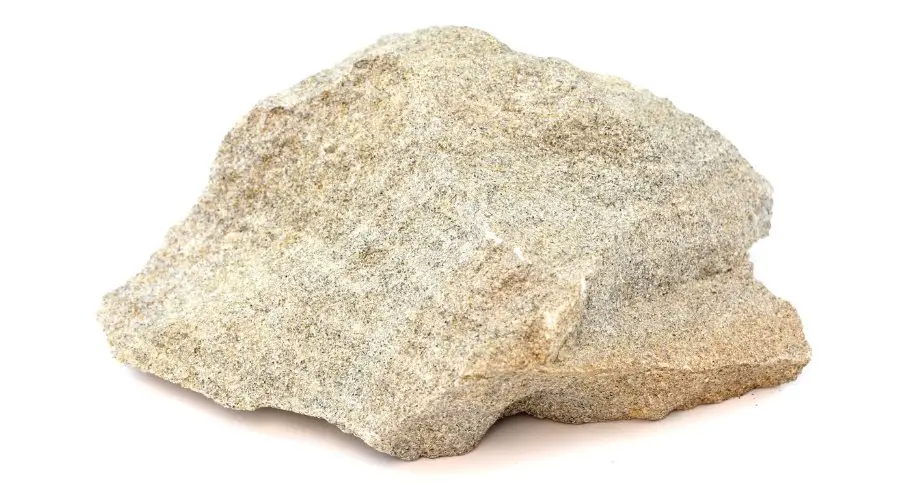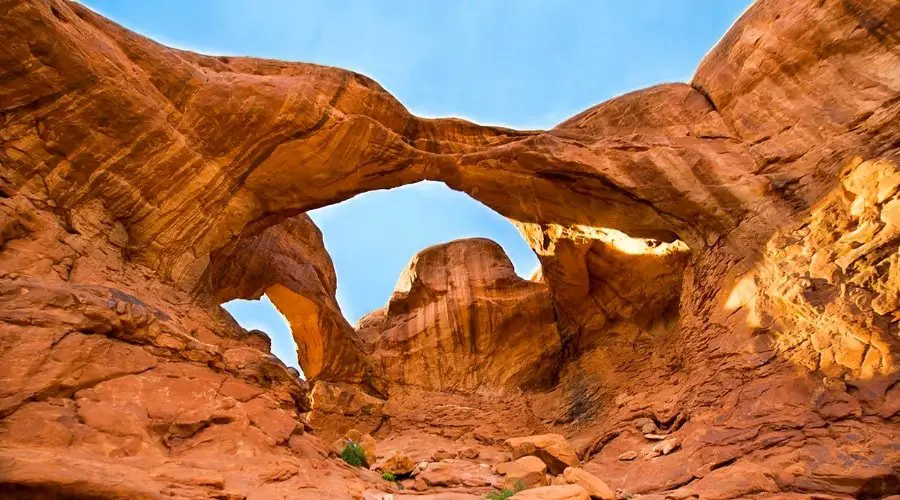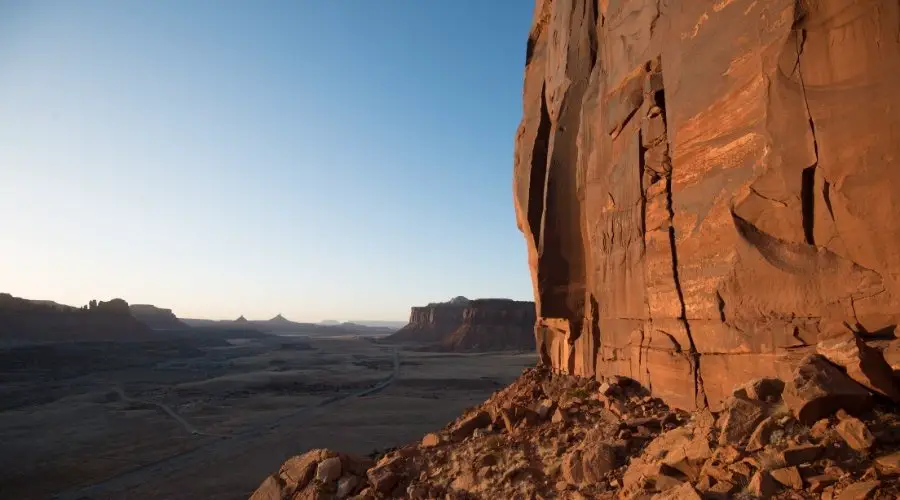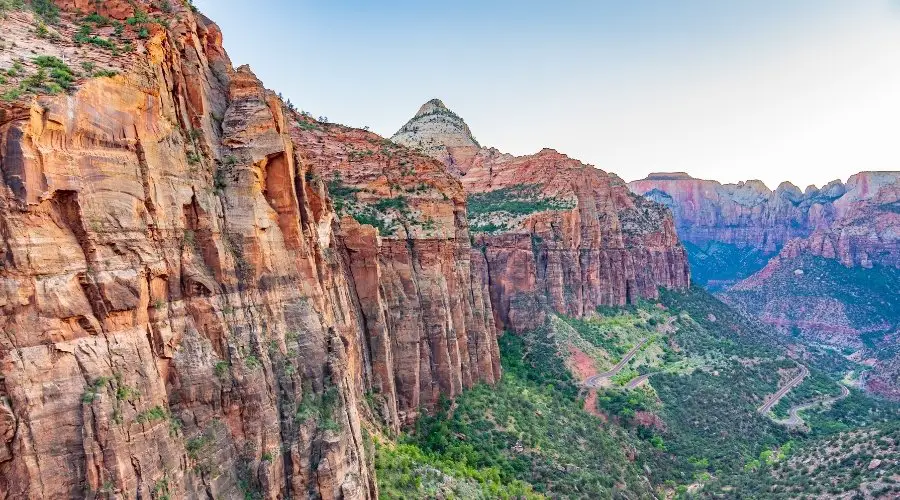Some of the most popular rock climbing areas in the world are sandstone climbs. That said, other sandstone areas are incredibly weak and not suitable for climbing. As a geologist, I was pretty curious to see how sandstone’s characteristics lend themselves to rock climbing. Here is what I found out:
As a general rule, pristine sandstone is some of the best rock for climbing. Sandstone formations are typically heavily featured and provide climbers with a wide variety of climbing holds. Sandstone is generally not ideal for trad climbing and is too weak and soft to climb on when wet.
While some pristine, dry sandstone is absolutely fantastic to climb, other sandstones can be quite chossy and terrible for climbing. This article details how different sandstone’s characteristics affect climbing and lists some of the best spots for sandstone rock climbing at the end!
If you are a big geology nerd like myself and want to learn more how all rock types affect climbing, I recommend checking out this book on Amazon!
How Good is Sandstone For Rock Climbing

Sandstone is one of the most common sedimentary rocks in the world. Its structure allows it to be easily shaped by the elements and create one of a kind climbing routes.
Sandstone is a sedimentary rock composed of sand sized grains of rock fragments held together by a cementing material. The individual rock fragments can either be single minerals (commonly quartz and/or feldspar) or small pieces of older rocks that are composed of multiple minerals (referred to as lithic fragments). The cementing material is typically formed following the burial of the sand via dissolution or alteration. Silica and calcium carbonate cements are the most common cement materials.
Whether you are looking to refresh your sandstone geology knowledge or are curious in learning more behind the science of sandstone, I recommend checking out the information on GeologyScience.com. If you are wondering if there is a best rock for climbing, check out my article here.
Feel and Friction Of Sandstone For Climbing
The amalgamation of grains causes sandstone to be very textured and gritty to touch. This texture provides climbers with a lot of friction and grip on the rock but it can also be very abrasive to climbers’ hands if they are sliding their hands and are re-gripping too frequently.

Some sandstones will be rougher on climbers’ hands than others. The grains of sand in the stone can either be more rounded or more angular (sharper) depending on how much abrasion they have sustained. Grains tend to start angular and transition to being more round with age as they get subjected to more abrasion processes.
Obviously, the more mature the grains in the sandstone, the more friendly it will be on a climber’s hands.
Sandstone’s Strength and Durability For Climbing
A lot of sandstones have been described as fragile and have made climbers very nervous while climbing on them.
While the individual grains in sandstone are typically composed of hard, crystalline minerals such as quartz, there is typically a lot of “empty space” between the grains and the cementing matrix is not as hard or durable. This causes sandstones to be overall softer and weaker than other rocks such as granite.
Due to sandstone’s relative weakness, it typically does not provide climbers with as solid of protection placement as other stronger rocks. This makes the average sandstone not suitable for trad climbing. Of course there are some pretty bombproof sandstones out there but these are the exception, not the rule.
As a general rule, sandstone is better suited for top roping and bouldering than it is for trad or aid climbing (unlike granite). Strong pristine sandstone can provide fantastic sport climbing experiences while soft and weak sandstone is not suitable for sport climbing at all.
Typical Sandstone Rock Climbing Features

Because sandstone is weaker and more easily susceptible to erosion, it typically becomes incredibly featured (much more than other rocks like granite). In general, sandstone is able to provide climbers with basically any natural climbing feature imaginable from large vertical crack networks to overhanging juggy cliffs or even to mountainous slabs.
All of these features in the sandstone provide climbers with some of the most unique and interesting climbing on earth. The degree to which sandstone becomes featured not only depends on the environment it is in but the chemical and physical composition of the sandstone itself.
Sandstone with a high iron content will typically be harder and more solid than sandstones with lower iron contents. Sandstones with a large percent of iron will typically be red or even black. These rocks tend to have less drastic features and provide climbers with more slopey holds than other sandstones.
Calcite cemented sandstones typically will be very soft, weak, and extremely featured. While they provide climbers with almost any feature they can imagine, they are typically not safe to climb on. Calcite cemented sandstones are very porous to begin with and become even more porous when the calcite cement starts to dissolve in acidic water.
Silica cemented sandstone can kind of be thought of as a happy medium between the two in the climbing world. While not as hard as sandstone with high iron contents, silica cemented sandstone is very good at resisting weathering as it does not dissolve in water like the calcite cement. This allows the rock to maintain a relatively good strength while providing more features than iron rich sandstones.
The Effects of Weather Conditions and Weathering on Sandstone Climbing

Weather conditions such as rain and snow have both short and long term effects on rocks.
How Weather Conditions Affect Climbing on Sandstone
Sandstone is an incredibly porous rock. This means that a lot of water can be easily absorbed into the rock during a rainstorm or other weather event. While this may not seem like a big deal, it is. Rocks begin to lose their strength and become more susceptible to breaking when they are wet. This can be a huge problem in the climbing world as sandstone is already a weaker rock to begin with.
In addition to this, because of the amount of water sandstone is able to absorb, it takes a long time for it to completely dry out. As a general rule of thumb, you should always wait at-least 48 hours after a rainstorm before climbing on sandstone. Even then, the rock may still be wet depending on the amount of precipitation and other environmental factors such as wind, temperature, humidity, cloud cover, etc.
As a general rule, you should never climb on wet sandstone. Sandstone’s high porosity allows a lot of water to be absorbed into the rock and weakens its integrity. Climbing on sandstone when wet can break holds off of the route and is extremely dangerous. Sandstone can take over three days to completely dry out after a rainstorm.
How Long Term Weathering Affects Climbing on Sandstone
As we mentioned above, the chemical and physical composition of the sandstones affect how featured the rock becomes. These features in the rock are caused by long term exposure to weathering processes such as wind, precipitation, etc.
Although the individual grains in the sandstone are typically relatively weather resistant, the cement material holding it together and the large pore space in the rock make it very susceptible to erosion.
The most obvious example of this is calcite cemented sandstone which is very susceptible to erosion as cement material holding the rock together actually dissolves in acidic water (just like limestone). On the other hand, iron rich sandstones have actually been found to get stronger and harden over time in dry climates and resist weathering well.
As a general rule, sandstone will become more brittle and start to break or crumble into sand as it weathers over time. This is what makes some of the sandstone routes feel “chossy”. It is because the rock is actually deteriorating and turning back into sand.
As you may have guessed, climbing and placing protection on weathered sandstone is extremely dangerous. DO NOT DO THIS. Only climb on sandstone that you know is fresh and solid. It is not worth taking the risk.
Best Places to Climb On Sandstone

Let’s take a look at some of the best sandstone climbing areas in the world. Below are 9 areas with absolutely magnificent sandstone climbing routes/problems.
9 of the Best Spots For Sandstone Rock Climbing
- Red Rock, Nevada
- Indian Creek, Utah
- Moab, Utah
- Zion National Park, Utah
- Garden of the Gods, Colorado
- New River Gorge, West Virginia
- Red River Gorge, Kentucky
- Eldorado Canyon State Park (Eldo), Colorado
- Sedona, Arizona
Every single spot above provides climbers with unbelievable sandstone climbing experiences.
Disclaimer: Rock climbing is a dangerous sport which has the potential to result in serious injury or death. This article was written solely to provide information and insight pertaining to the relationship between geology and rock climbing. The information in this article is not to be relied on for guidance pertaining to the health and safety of any rock climbing activities.
